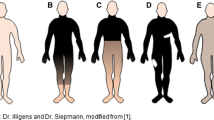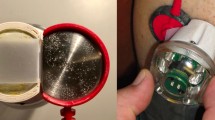Abstract
Sudomotor dysfunction is common in many subtypes of neuropathy but is one of the earliest detectable neurophysiologic abnormalities in distal small fiber neuropathy. Clinical assessments of sudomotor function include thermoregulatory sweat testing (TST), quantitative sudomotor axon reflex testing (QSART), silicone impressions, the sympathetic skin response (SSR), the acetylcholine sweat-spot test and quantitative direct and indirect axon reflex testing (QDIRT). These testing techniques, when used in combination, can detect and localize pre- and postganglionic lesions, can provide early diagnosis of sudomotor dysfunction and can monitor disease progression or disease recovery. In this article, we describe many of the common clinical tests available for evaluation of sudomotor function with focus on the testing methodology and limitations while providing concrete examples of test results.








Similar content being viewed by others
References
Berghoff M, Kilo S, Hilz MJ, Freeman R (2006) Differential impairment of the sudomotor and nociceptor axon-reflex in diabetic peripheral neuropathy. Muscle Nerve 33:494–499
Boulant JA (1981) Hypothalamic mechanisms in thermoregulation. Fed Proc 40:2843–2850
Caccia MR, Dezuanni E, Salvaggio A, Osio M, Bevilacqua M, Norbiato G, Mangoni A (1991) Sympathetic skin response versus maximum motor and sensory conduction velocity to detect subclinical neuropathy in non- insulin-dependent diabetics. Acta Neurologica Belgica 91:213–222
Dawson ME, Rissling AJ, Schell AM, Wilcox R (2007) Under what conditions can human affective conditioning occur without contingency awareness? Test of the evaluative conditioning paradigm. Emotion 7:755–766
Edelberg R (1977) Relation of electrical properties of skin to structure and physiologic state. J Invest Dermatol 69:324–327
Elie B, Guiheneuc P (1990) Sympathetic skin response: normal results in different experimental conditions. Electroencephal Clin Neurophysiol 76:258–267
Fagius J, Wallin BG (1980) Sympathetic reflex latencies and conduction velocities in normal man. J Neurol Sci 47:433–448
Fealey RD (2008) Thermoregulatory sweat test. In: Low PA, Benarroch EE (eds) Clinical autonomic disorders: evaluation and management. Lippincott Williams & Wilkins, Philadelphia, pp 261–281
Fealey RD, Low PA, Thomas JE (1989) Thermoregulatory sweating abnormalities in diabetes mellitus. Mayo Clinic Proc 64:617–628
Gibbons C, Freeman R (2004) The evaluation of small fiber function-autonomic and quantitative sensory testing. Neurol Clin 22:683–702
Gibbons CH, Illigens BM, Centi J, Freeman R (2008) QDIRT: quantitative direct and indirect test of sudomotor function. Neurology 70:2299–2304
Guttman L, Silver J, Wyndham CH (1958) Thermoregulation in spinal man. J Physiol 142:406–419
Hilz MJ, Stemper B, Axelrod FB (1999) Sympathetic skin response differentiates hereditary sensory autonomic neuropathies III and IV. Neurology 52:1652–1657
Hoeldtke RD, Davis KM, Hshieh PB, Gaspar SR, Dworkin GE (1992) Autonomic surface potential analysis: assessment of reproducibility and sensitivity. Muscle Nerve 15:926–931
Kennedy WR, Sakuta M, Sutherland D, Goetz FC (1984) Quantitation of the sweating deficiency in diabetes mellitus. Ann Neurol 15:482–488
Kennedy WR, Sakuta M, Sutherland D, Goetz FC (1984) The sweating deficiency in diabetes mellitus: methods of quantitation and clinical correlation. Neurology 34:758–763
Kihara M, Opfer-Gehrking TL, Low PA (1993) Comparison of directly stimulated with axon reflex-mediated sudomotor responses in human subjects and in patients with diabetes. Muscle Nerve 16:655–660
Knezevic W, Bajada S (1985) Peripheral autonomic surface potential. A quantitative technique for recording sympathetic conduction in man. J Neurol Sci 67:239–251
Knezevic W, Bajada S (1985) Peripheral autonomic surface potential: a quantitative technique for recording autonomic neural function in man. Clin Exp Neurol 21:201–210
Lader MH, Montagu JD (1962) The psycho-galvanic reflex: a pharmacological study of the peripheral mechanism. J Neurol Neurosurg Psychiatry 25:126–133
Linden D, Berlit P (1995) Sympathetic skin responses (SSRs) in monofocal brain lesions: topographical aspects of central sympathetic pathways. Acta Neurol Scand 91:372–376
Low PA (2004) Evaluation of sudomotor function. Clin Neurophysiol 115:1506–1513
Low PA (1993) Pitfalls in autonomic testing. In: Clinical autonomic disorders: evaluation and management. Little, Brown and Company, Boston, pp 355–365
Low PA (2003) Testing the autonomic nervous system. Semin Neurol 23:407–421
Low PA, Caskey PE, Tuck RR, Fealey RD, Dyck PJ (1983) Quantitative sudomotor axon reflex test in normal and neuropathic subjects. Ann Neurol 14:573–580
Low PA, Dyck PJ (1978) Splanchnic preganglionic neurons in man. III. Morphometry of myelinated fibers of rami communicantes. J Neuropathol Exp Neurol 37:734–740
Low PA, Dyck PJ (1977) Splanchnic preganglionic neurons in man: II. Morphometry of myelinated fibers of T7 ventral spinal root. Acta Neuropathologica 40:219–225
Low PA, Fealey RD, Sheps SG, Su WP, Trautmann JC, Kuntz NL (1985) Chronic idiopathic anhidrosis. Ann Neurol 18:344–348
Low PA, Okazaki H, Dyck PJ (1977) Splanchnic preganglionic neurons in man. I. Morphometry of preganglionic cytons. Acta Neuropathologica 40:55–61
Low VA, Sandroni P, Fealey RD, Low PA (2006) Detection of small-fiber neuropathy by sudomotor testing. Muscle Nerve 34:57–61
Mandikos MN (1998) Polyvinyl siloxane impression materials: an update on clinical use. Aust Dental J 43:428–434
Meijer EH, Smulders FT, Johnston JE, Merckelbach HL (2007) Combining skin conductance and forced choice in the detection of concealed information. Psychophysiology 44:814–822
Namer B, Bickel A, Kramer H, Birklein F, Schmelz M (2004) Chemically and electrically induced sweating and flare reaction. Auton Neurosci 114:72–82
Ryder RE, Marshall R, Johnson K, Ryder AP, Owens DR, Hayes TM (1988) Acetylcholine sweatspot test for autonomic denervation. Lancet 1:1303–1305
Sato K, Dobson RL (1970) Regional and individual variations in the function of the human eccrine sweat gland. J Invest Dermatol 54:443–449
Schmidt KD, Chan CW (1992) Thermoregulation and fever in normal persons and in those with spinal cord injuries. Mayo Clin Proc 67:469–475
Shahani BT, Halperin JJ, Boulu P, Cohen J (1984) Sympathetic skin response–a method of assessing unmyelinated axon dysfunction in peripheral neuropathies. J Neurol Neurosurg Psychiatry 47:536–542
Stewart JD, Nguyen DM, Abrahamowicz M (1994) Quantitative sweat testing using acetylcholine for direct and axon reflex mediated stimulation with silicone mold recording; controls versus neuropathic diabetics. Muscle Nerve 17:1370–1377
Uncini A, Pullman SL, Lovelace RE, Gambi D (1988) The sympathetic skin response: normal values, elucidation of afferent components and application limits. J Neurol Sci 87:299–306
Vetrugno R, Liguori R, Cortelli P, Montagna P (2003) Sympathetic skin response: basic mechanisms and clinical applications. Clin Auton Res 13:256–270
Vilches JJ, Navarro X (2002) New silicones for the evaluation of sudomotor function with the impression mold technique. Clin Auton Res 12:20–23
Author information
Authors and Affiliations
Corresponding author
Rights and permissions
About this article
Cite this article
Illigens, B.M.W., Gibbons, C.H. Sweat testing to evaluate autonomic function. Clin Auton Res 19, 79–87 (2009). https://doi.org/10.1007/s10286-008-0506-8
Received:
Accepted:
Published:
Issue Date:
DOI: https://doi.org/10.1007/s10286-008-0506-8




